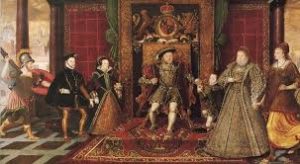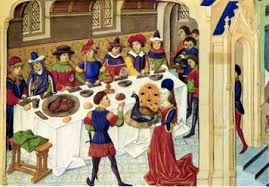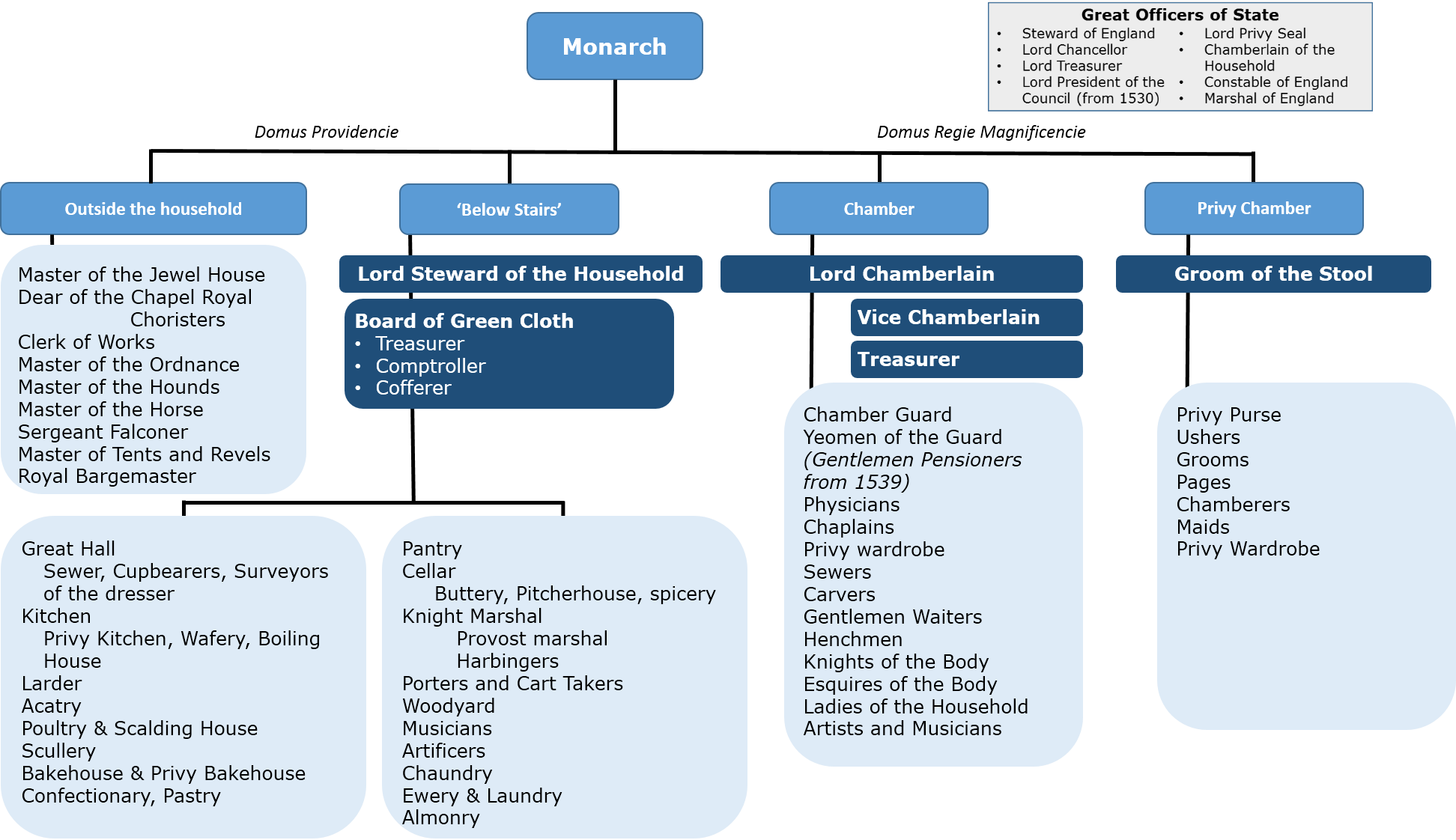The king was the government. His household was to serve all his needs – and provide a properly magnificent ceremonial setting for his glory and power.
Government and the Great Offices of State
The curia regis was the centre of government, and a court of law. As bureaucracy had grown from the itinerant, medieval court, the most important of the great offices of State derived become stationary, based in Westminster Hall, and acquired their own bureaucracies. The King’s Council was purely an advisory body.
The Household as a centre of politics and patronage
 Early Tudor government probably employed around 1,500 people. Such a small government (compared to modern times) was therefore severely restricted in it what it could do, and relied on the nobility and gentry of the country to rule. Nonetheless, the patronage these jobs provided was larger than any available elsewhere; it was said that there were 175 posts of court which could support a gentleman, and over which patronage the families of the magnates, barons and gentry squabbled. For any scions of the peerage, court was where to find influence, power and patronage; for artists, musicians, scholars it was the source of commissions and a future. The medieval and Tudor court was unlike any institution we have today – a public meeting place and centre of power.
Early Tudor government probably employed around 1,500 people. Such a small government (compared to modern times) was therefore severely restricted in it what it could do, and relied on the nobility and gentry of the country to rule. Nonetheless, the patronage these jobs provided was larger than any available elsewhere; it was said that there were 175 posts of court which could support a gentleman, and over which patronage the families of the magnates, barons and gentry squabbled. For any scions of the peerage, court was where to find influence, power and patronage; for artists, musicians, scholars it was the source of commissions and a future. The medieval and Tudor court was unlike any institution we have today – a public meeting place and centre of power.
The Household – service and magnificence
The purpose of the royal household was to provide for all of the monarch’s needs. This meant their personal needs,  but also their needs as the head and seat of government. The setting was critical – magnificence, display and ceremonial was an integral part of the monarchy, it was expected, demanded and necessary. The court therefore often absorbed a third of the monarch’s ordinary revenues.
but also their needs as the head and seat of government. The setting was critical – magnificence, display and ceremonial was an integral part of the monarchy, it was expected, demanded and necessary. The court therefore often absorbed a third of the monarch’s ordinary revenues.
The household had therefore two main divisions; the domus providencie was the practical stuff – linen, food, transport, the hunt all that. Below stairs if you like. In 1558 there were 290 people working under the Steward of the Household. The domus regie magnificencie was the front of house stuff – the business of government, and the public face of the king – required therefore to display the magnificence of the monarch.
From Two to three Chambers: Henry VII
Traditionally, the court was based on the ancient concept of the lord’s Great Hall – a single hall where the monarch met, ate, consulted and played with their great men. Then a Presence Chamber was added – a throne room, still a public room. These rooms together were called the Chamber. It was peopled by the great and the good, unlike most of the posts ‘below stairs’, and maybe surprisingly was much bigger than below stairs. The leading posts would be taken by the magnates; Henry VII’s Chamberlain until 1494, head of the Chamber, was William Stanley, the man who had picked his crown from the thornbush. Other posts would be taken by the nobility and gentry.
The concept was very different from the structure of the courts of the Italian Renaissance. There, a Prince expected to have his own ‘closet’ or office, where they would work, surrounded not by the great men who would constantly use their position to exert political influence, but by bureaucrats, dependent on and totally subservient to the monarch.
The medieval household was therefore thought of as having two chambers – the below stairs domus providencie, and the Chamber. Henry VII preferred the Italian model. He wanted private rooms where he could work without distraction, without political pressure. He did not know well, and distrusted the nobility; he wanted a bureaucracy to do his will.
So he created the Guard Chamber before the Great Hall, guarded by his new Yeomen of the Guard. He added the Privy Chamber to the great hall. A room, soon to be a complex of bedrooms and closets, behind the dais of the Chamber. These were not public rooms. Only the monarch and authorised staff could go here.
 The Privy Chamber the centre of king’s power
The Privy Chamber the centre of king’s power
The Privy Chamber was peopled by Henry’s appointees – men drawn from the middling sort, the most exalted from the gentry. Here was Henry VII’s inner Council the men he trusted and implemented his will – you can see and article here about these men. The head of the Privy Chamber was the Groom of the Stool; Hugh Denys, under Henry VII. Traditionally there to help the king with his ablutions, it became a powerful role, controlling access to the king. Henry then followed the practice of Edward IV in moving fiscal management and policy from the slow, cumbersome Exchequer to the Privy Chamber; and the Groom of the Stool effectively became the king’s finance minister. With the arrival of Queen Mary, the role lost influence and became once again as it had been.
Roles in the Royal Household
Many of these roles are hideously obscure, especially below stairs. Here’s a brief glossary, where I know the answer. Where I don’t, please add a comment if you do!
- Acatry: Responsible for storing meat and fish
- Almonry: Distribution of alms. Nothing to do with Almonds.
- Chaundry: Candles
- Cofferer: Treasurer. In the royal household, he was essentially the operational boss
- Ewery: Storage of ewers (should have guessed that), linen and towels
- Harbinger: Finds and provides lodgings.
- Henchman: From old English hengst, for stallion. A groom who accompanied lords and great men in processions; in Scotland the right hand man of the chief.
- Knight Marshal: Maintaining order at the King’s court. Moves to the Earl Marshal under Henry VIII.
- Larder: storage of meat, probably bacon
- Master of the Jewel House: keeper of the monarch’s private treasury. From 1042 to the 13th century, the role was held by Westminster Abbey.
- Pantry: Storage of bread
- Scullery: care of plates, dishes and utensils
- Sewers: Attendants at meals who organised seating and serving of guests
Prepared with the help of the really rather fantastic ‘Hudson’s English History’ by Roger Hudson, which is worth every penny.

Nice one. I still find it hard to believe anyone wanted the groom of the stool job.
Does seems a little difficult to grasp doesn’t it? As it were.
It was the most important job. You are the one person to have the King’s intimate ear and you controlled access to him. People came to you for favours. That’s why you wanted that job. They didn’t actually wipe the royal bottom. They handed him the towels to do so, but they where the person closest to the king, so the most important person around him.
Fascinating thank you, especially given that I had been wondering about the nature of Court. Surprised that government employed as many as 1,500. It’s now 400,000 (plus the forces, NHS etc).
Loved the definitions of roles, particularly Harbinger. Presumably gets its modern usage because the harbinger was the chap who would turn up in advance of the Royal party. And there was really a job of Henchman! I wonder if they were all evil?!
Yes! Both harbinger and henchmen used to be entirely positive words!
Harbinger: Finds and provides lodgings. Interesting. I wonder how this word came to its current meaning?
I think harbinger means pretty much the same thing now as it did then in a way; harbingers would have rode out, and come back with news of where lodgings were (or were not); so I guess harbinger of doom simply means someone who came back with bad news. Sewers…don’t know about that.
As for sewer – it’s just coincidence. The drainage sewer comes from Old French, “essouere” drain, ditch. Sewer as attendant comes from the Old French “asseoir” to cause to sit, seat, and Latin “assidēre”, to sit. Or so says OED anyhow!
And the same with sewers. :S
I do love your podcast, I’m a disabled American Vet from the Air Force and the Army, I look forward to all your podcast. Thank You
How lovely of you! Thanks for taking the trouble to say so!
What tasks were assigned to the “Henchmen” under the Lord Chamberlain?
It’s rather nice isn’t it, to see the original word and use of Henchman? A few years ago, people also started to use the word ‘hench’ with the meaning of strong, competent.
Hench comes from the old English for stallion, hengst, according to the OED. A henchman was a squire, or page of honour who walked or rode beside their Prince in processions and so on. I’m told also that there’s a suggestion that it becomes specifically a groom,, though OED is less sure about that. Interestingly in Scotland by 18th Century it’s become the word for the personal attendant of a Highland Chief; thought there’s some debate as to whether or not the etymology is the same; this usage could come from the word Haunch, which suggests someone standing at the chief’s side.
Excellent detail (as usual), any detail on how the household staff was chosen? Were these people who had experience in these areas, or just generalized help that had to learn each role?
I don’t know to be honest; I suspect it was a matter of who you know. But I would recommend a book I’ve just started reading; it’s by Tracy Borman, The Private Lives of the Tudors.l It’s a lot about below stairs as well as front of house as it were
Hi David,
Here’s one out of left field for you. Can you tell me who were likely tutors from either Oxford or Cambridge appointed to the Royal tudor court as tutors? Im doing a classics paper and I’d like to know if they studied Ovid?
Thank you, Velda Dyer
Ooh that’s too detailed for me I’d need to research and I’m not currently in a good position to do that. Obviously they were very classics oriented by |Tudor times, though Cicero was the big draw. Not sure if Ovid made it, sorry